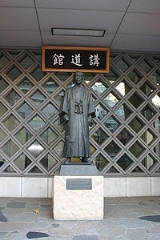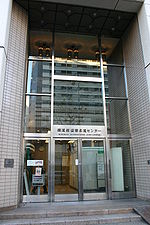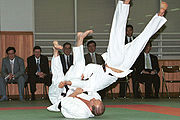
Kodokan
Encyclopedia
, or the Kodokan Institute, is the headquarters of the worldwide judo
community. Literally, kō means "to lecture" or "to spread information," dō means "the way," and kan is "a public building or hall," together translating roughly as "a place for the study or promotion of the way." The Kodokan was founded in 1882 by Kanō Jigorō
, the founder of judo, and is now located in an eight-story building in Tokyo
, Japan
.
 The Kodokan Institute offers classes for those who want to master judo. The program is authorized as a non-regular school by the Tokyo Metropolitan Government. Its courses include the theories and practice of judo, and matters of general education. The course is divided into two parts: a general course for novice
The Kodokan Institute offers classes for those who want to master judo. The program is authorized as a non-regular school by the Tokyo Metropolitan Government. Its courses include the theories and practice of judo, and matters of general education. The course is divided into two parts: a general course for novice
s, and special courses for those who have completed the general course or its equivalent.
The Kodokan also issues ranks, and many judoka (practitioners of judo) around the world become Kodokan members and have their ranks registered with the Kodokan.
The Institute was founded with only nine disciples. The growth of judo in its early years is demonstrated by the growth of the Kodokan itself:
Today, the Kodokan has 1,206 mats across the five main dojo (training halls)—Main, School, International, Women's, and Boys'—plus a special dojo for retired judoka and special technique study purposes.
 There are eight floors and a basement to the Kodokan dojo
There are eight floors and a basement to the Kodokan dojo
, each serving purposes for housing, training, and research by judoka. The basement holds the cafeteria and some conference rooms. The first floor has parking, a bank, and a store. The second floor contains a library and more conference rooms. The third floor is for judoka and visitors who are living in the dojo. The fourth floor contains dressing rooms. The fifth, sixth, and seventh floors are all used for training space (the seventh floor is called the Main Dojo), and the eighth floor is for spectators and has seats that look down into the main space of the seventh floor.
There are four research laboratories on the second floor:
The research staff use fundamental and applied science to work with foreign researchers. Research is displayed to the public and free of charge to view once during the year.
The lodging fees are as follows:
session with foreign students.
(judo uniforms) are generally allowed in the Kodokan (except for special occasions and foreign guests for whom they may show some tolerance). Wearing blue or any other color judogi is considered disrespectful, as the white judogi is traditional and has cultural significance. Undershirts for men are not allowed.
Judo
is a modern martial art and combat sport created in Japan in 1882 by Jigoro Kano. Its most prominent feature is its competitive element, where the object is to either throw or takedown one's opponent to the ground, immobilize or otherwise subdue one's opponent with a grappling maneuver, or force an...
community. Literally, kō means "to lecture" or "to spread information," dō means "the way," and kan is "a public building or hall," together translating roughly as "a place for the study or promotion of the way." The Kodokan was founded in 1882 by Kanō Jigorō
Kano Jigoro
was the founder of judo. Judo was the first Japanese martial art to gain widespread international recognition, and the first to become an official Olympic sport. Pedagogical innovations attributed to Kanō include the use of black and white belts, and the introduction of dan ranking to show the...
, the founder of judo, and is now located in an eight-story building in Tokyo
Tokyo
, ; officially , is one of the 47 prefectures of Japan. Tokyo is the capital of Japan, the center of the Greater Tokyo Area, and the largest metropolitan area of Japan. It is the seat of the Japanese government and the Imperial Palace, and the home of the Japanese Imperial Family...
, Japan
Japan
Japan is an island nation in East Asia. Located in the Pacific Ocean, it lies to the east of the Sea of Japan, China, North Korea, South Korea and Russia, stretching from the Sea of Okhotsk in the north to the East China Sea and Taiwan in the south...
.
Function

Novice
A novice is a person or creature who is new to a field or activity. The term is most commonly applied in religion and sports.-Buddhism:In many Buddhist orders, a man or woman who intends to take ordination must first become a novice, adopting part of the monastic code indicated in the vinaya and...
s, and special courses for those who have completed the general course or its equivalent.
The Kodokan also issues ranks, and many judoka (practitioners of judo) around the world become Kodokan members and have their ranks registered with the Kodokan.
The Institute was founded with only nine disciples. The growth of judo in its early years is demonstrated by the growth of the Kodokan itself:
- 12 mats - May 1882, at the Eishōji, a Buddhist temple in KamakuraKamakura, Kanagawais a city located in Kanagawa Prefecture, Japan, about south-south-west of Tokyo. It used to be also called .Although Kamakura proper is today rather small, it is often described in history books as a former de facto capital of Japan as the seat of the Shogunate and of the Regency during the...
- 10 mats - February 1883, at Jimbōchō, Kanda
- 20 mats - September 1883, at Shihan's house, Kōjimachi
- 40 mats - Spring 1887, at Shinagawa's house, Kōjimachi
- 60 mats - April 1890, at Hongō-ku, Masaga-chō
- 107 mats - February 1894, at Koishikawa-chō, Shimotomisaka-chō
- 207 mats - November 1897, at Koishikawa, Shimotomisaka-chō
- 314 mats - January 1898, at Ōtsuka Sakashita-chō
- 514 mats - December 1919, at 1-chome Kasuga-chō, Bunkyō-ku
- 986 mats - March 1958, at 2-chome, Kasuga-chō, Bunkyō-ku
Today, the Kodokan has 1,206 mats across the five main dojo (training halls)—Main, School, International, Women's, and Boys'—plus a special dojo for retired judoka and special technique study purposes.
Building

Dojo
A is a Japanese term which literally means "place of the way". Initially, dōjōs were adjunct to temples. The term can refer to a formal training place for any of the Japanese do arts but typically it is considered the formal gathering place for students of any Japanese martial arts style to...
, each serving purposes for housing, training, and research by judoka. The basement holds the cafeteria and some conference rooms. The first floor has parking, a bank, and a store. The second floor contains a library and more conference rooms. The third floor is for judoka and visitors who are living in the dojo. The fourth floor contains dressing rooms. The fifth, sixth, and seventh floors are all used for training space (the seventh floor is called the Main Dojo), and the eighth floor is for spectators and has seats that look down into the main space of the seventh floor.
Research floor
The Kano Memorial Hall, Historical hall, exhibition room, and material stock room are located on the second floor. The halls contain posters of the development of judo, as well as information on some of the great masters of the system, written documents, photographs, and other information on the life of Kano and the people he met through his travels. The extensive library on the second floor holds over 7,000 books pertaining to judo, and is planned to be increased eventually.There are four research laboratories on the second floor:
- 1st Lab: Theoretical and historical study of judo.
- 2nd Lab: Psychological study of judo.
- 3rd Lab: Technical analysis of judo. Research on the physical strength of judo players.
- 4th Lab: Physiological study of judo.
The research staff use fundamental and applied science to work with foreign researchers. Research is displayed to the public and free of charge to view once during the year.
Living in the Kodokan
Judoka visiting and training in the Kodokan can stay on the Third Floor. There are five rooms for use during training camps; these rooms can hold 20 people each. Judo sensei and players (when no camp is in session) may live in suites for either one or two people; these suites have their own baths and showers.The lodging fees are as follows:
- Room for training camps : 1 night / person 1,800 yen ($15.21 US)
- Single room : 1 night / person 3,500 yen ($29.58 US)
- Deluxe single room : 1 night / person 5,000 yen ($42.26 US)
- Deluxe twin room : 1 night / person 9,000 yen ($76.07 US)
- Extra bed : each 1,800 yen ($15.21 US)
Visiting the Kodokan
Short-term visitors to Tokyo can visit the Kodokan to watch or attend practice. Visitors may walk up to the main floor of the dojo to watch practice or competitions. Permission is required to attend the practice for transient students. One-time visitors are most likely to be allowed to take part in a randoriRandori
is a term used in Japanese martial arts to describe free-style practice. The term literally means "chaos taking" or "grasping freedom," implying a freedom from the structured practice of kata. Randori may be contrasted with kata, as two potentially complementary types of training.The exact meaning...
session with foreign students.
Main floor
The Main Dojo is found on the seventh floor. The dojo is carefully designed to give the precise amount of floor spring, brightness, and ventilation. Four official contests can be held at the same time in the Main Dojo on the seventh floor. It has 420 mats and approximately 900 spectators can be seated on the eighth floor. Medical equipment is provided in case of emergencies.Attire
Only white judogiJudogi
Judogi is the formal Japanese name for the traditional uniform used for Judo practice and competition. It is actually derived from traditional articles of Japanese clothing. Jigoro Kano derived the original judogi from the kimono and other Japanese garments around the turn of the 20th century, and...
(judo uniforms) are generally allowed in the Kodokan (except for special occasions and foreign guests for whom they may show some tolerance). Wearing blue or any other color judogi is considered disrespectful, as the white judogi is traditional and has cultural significance. Undershirts for men are not allowed.
External links
- Kodokan website
- "Judo History" - Judo history pages at JudoInfo.com

